- 10 - 11 SEPTEMBRE
- INDI-UNI : ANTHROPOLOGIE - ARCHEOLOGIE
INSCRIPTION 2011 – 2012 COURS A DISTANCE
REGISTRATION 2011 – 2012 ONLINE COURSES
- ROYAUME UNI – 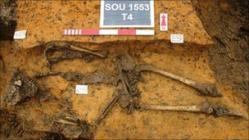 Southampton - The remains of nine people, believed to date to Saxon times, have been unearthed on a housing development in Southampton. The site in present-day St Mary Street is thought to have been the first cemetery of the old Saxon town of Hamwick from between 650 AD to 900 AD . Archaeologist Matt Garner explains more about the skeletons and some of the artefacts found with them.
Southampton - The remains of nine people, believed to date to Saxon times, have been unearthed on a housing development in Southampton. The site in present-day St Mary Street is thought to have been the first cemetery of the old Saxon town of Hamwick from between 650 AD to 900 AD . Archaeologist Matt Garner explains more about the skeletons and some of the artefacts found with them.
VIDEO = http://www.bbc.co.uk/news/uk-england-hampshire-14846954
- TURQUIE – 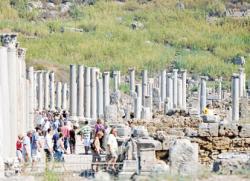 Perge - Archaeological work at the ancient city of Perge in southern Turkey passed the 65-year mark recently and is successfully restoring many columns along the city’s streets, according the leader of the excavations. Perge, also known as Perga, is located in southern Turkey’s Antalya province and is included on UNESCO’s world heritage list. “Over 65 years, we have unearthed 20 to 25 percent of the ancient city. The unearthed remains were some of the most important parts of the city,” said Abbasoğlu, who has been leading the excavations since 1985, adding that among those ruins there are two Turkish baths, city gates, an agora, streets, three fountains and some parts of houses. Abbasoğlu said the team unearthed and restored 25 columns along the ancient city’s main streets this year with money earned by selling tourist information guides. He said since the launch of the “Erect one column” campaign six years ago, they have unearthed 96 columns in total.
Perge - Archaeological work at the ancient city of Perge in southern Turkey passed the 65-year mark recently and is successfully restoring many columns along the city’s streets, according the leader of the excavations. Perge, also known as Perga, is located in southern Turkey’s Antalya province and is included on UNESCO’s world heritage list. “Over 65 years, we have unearthed 20 to 25 percent of the ancient city. The unearthed remains were some of the most important parts of the city,” said Abbasoğlu, who has been leading the excavations since 1985, adding that among those ruins there are two Turkish baths, city gates, an agora, streets, three fountains and some parts of houses. Abbasoğlu said the team unearthed and restored 25 columns along the ancient city’s main streets this year with money earned by selling tourist information guides. He said since the launch of the “Erect one column” campaign six years ago, they have unearthed 96 columns in total.
http://www.hurriyetdailynews.com/n.php?n=perge-excavations-turn-65-with-turkish-archaeologists-2011-09-09
- CANADA – Trois Rivières - Les aires de fouilles autour du flambeau à peine remblayées, c'est au tour du sol du parc de La Vérendrye de s'ouvrir aux recherches archéologiques. À compter de dimanche, 12 étudiants du Collège Laflèche exploreront l'environnement de la maison du gouverneur de Varennes, en quête de témoins de la vie quotidienne des ancêtres trifluviens. Il s'agit donc d'une troisième fouille du site sur lequel se trouvait la maison natale de Pierre Gaultier de Varennes, sieur de La Vérendrye, explorateur auquel on attribue la «découverte» des montagnes rocheuses et de l'Ouest canadien. C'est son père, René Gaultier de Varennes, gouverneur de Trois-Rivières, qui habitait la maison avec sa famille. L'habitation aurait été construite entre 1675 et 1679 et détruite au milieu du XVIIIe siècle. Une autre demeure y fut érigée à la fin du même siècle, désignée sur certains documents comme celle «de la veuve Bourbeau», et incendiée en 1870. Des vestiges associés aux deux maisons avaient été découverts en 1983 et en 2003. En 2010, les étudiants du Collège Laflèche ont aussi pu mettre au jour des traces de la maison du gouverneur de Varennes. «L'année dernière, on a trouvé des vestiges dont le mur sud et une partie de l'âtre. Cette année, on va poursuivre pour tenter de voir comment le mur avait été fait, le documenter», explique Louis Gilbert, archéologue en charge du chantier-école du Collège Laflèche. Les 12 étudiants encadrés par quatre archéologues auront l'occasion de fouiller ce qui est communément appelé un dépotoir, ou plus proprement dit un «dépôt domestique». «Dans ce temps-là aussi, on faisait le ménage, mais on jetait les choses dehors, dans la cour!», indique M. Gilbert. Ces poubelles à ciel ouvert recèlent d'importants artefacts illustrant la vie quotidienne, comme des pièces de vaisselle ou des ossements d'animaux témoignant des habitudes alimentaires, ou encore des boutons ou des éléments de parure évocateurs de l'habillement et de l'apparence.
http://www.cyberpresse.ca/le-nouvelliste/arts-spectacles/201109/09/01-4432921-fouilles-archeologiques-au-tour-du-parc-de-la-verendrye.php
- FRANCE – Narbonne - Au pied du domaine du grand Castelou, l'expert s'émerveille des dernières trouvailles mises au jour par Corinne Sanchez, chargée de recherches au CNRS en archéologie des sites méditerranéens, et son équipe. Morceaux de colonnes et de chapiteaux, marbres de Carrare et de Turquie, sculptures de rosace et de chevaux émergent comme par enchantement des actuels sites de fouilles. Des lieux qui racontent Narbonne la Romaine au temps de l'antiquité et son mode de vie d'alors avec ses ports, ses embarcadères et canaux, son Capitole et autres monuments. Direction, pour certains de ces trésors de l'histoire, le Musée Lapidaire de Narbonne qui abrite déjà autant de richesses. D'autres resteront in situ, recouvertes d'eau dès la prochaine équinoxe. Mais dans l'attente de la réalisation du Musée de la Romanité. Le projet arrive en phase de procréation. Jacques Michaud et Corinne Sanchez qui oeuvre dans le cadre d'un protocole de partenariat entre la Région Languedoc-Roussillon, l'Université Paul-Valéry, l'INRAP et le Ministère de la Culture, envisagent sa concrétisation pour 2015. En cette fin d'année, les cinq architectes sélectionnés doivent rendre une esquisse de leur proposition et l'un d'entre eux sera l'élu. En charge d'ériger ce Musée de la Romanité promis à un avenir international. Antique et éternel.
VIDEO = http://www.lindependant.fr/2011/09/10/descente-en-sous-sol-au-coeur-de-la-fabuleuse-petite-rome-antique,60150.php
- AUSTRALIE – 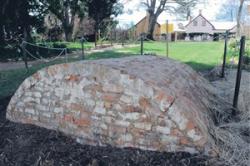 Lanyon – It may not rival Stonehenge in size. But a half-buried brick structure at Lanyon Homestead is an archaeological mystery that has local historians scratching their heads. The 2sqm brick vault, hidden for decades, was recently uncovered by gardeners clearing a thick tangle of vines. The materials for the bricks and mortar structure are thought to have been sourced locally and resemble other brickwork on the site dating from the 1800s. The structure also shows signs of whitewashing in the past. But the function of the building has experts at a loss. Theories include that it was a grain or food store, an early septic tank, water reservoir and even a bushfire shelter.
Lanyon – It may not rival Stonehenge in size. But a half-buried brick structure at Lanyon Homestead is an archaeological mystery that has local historians scratching their heads. The 2sqm brick vault, hidden for decades, was recently uncovered by gardeners clearing a thick tangle of vines. The materials for the bricks and mortar structure are thought to have been sourced locally and resemble other brickwork on the site dating from the 1800s. The structure also shows signs of whitewashing in the past. But the function of the building has experts at a loss. Theories include that it was a grain or food store, an early septic tank, water reservoir and even a bushfire shelter.
http://www.canberratimes.com.au/news/local/news/general/lanyon-vault-baffles-experts/2287731.aspx
- ISRAËL – Jérusalem - Understanding underground Jerusalem. Experts and hundreds of visitors attended the 12th annual City of David Archaeology Conference dedicated to research on Jerusalem and the city of David.
VIDEO = http://www.youtube.com/watch?v=JFay9kNU_dk
- GRECE – 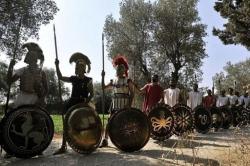 Marathon - Sweating beneath heavy armour, a group of die-hard archaeology fans brought the Battle of Marathon to life this weekend on the coastal plain where the fate of Europe dramatically changed 2,500 years ago. Gathering from Europe, North America and Australia, the re-enactors staged a three-day event of combat, archaic culture revival and commemoration at Marathon Bay never before seen in Greece despite its rich archaeological heritage. One of history's most famous military engagements, the Battle of Marathon is also one of the first to be recorded by chroniclers. It gave its name to the world's premier long-distance running event, inaugurated during the first modern Olympics in 1896 in honour of an Athenian messenger believed to have run back to the city to deliver news of the victory, and subsequently dying of exhaustion.
Marathon - Sweating beneath heavy armour, a group of die-hard archaeology fans brought the Battle of Marathon to life this weekend on the coastal plain where the fate of Europe dramatically changed 2,500 years ago. Gathering from Europe, North America and Australia, the re-enactors staged a three-day event of combat, archaic culture revival and commemoration at Marathon Bay never before seen in Greece despite its rich archaeological heritage. One of history's most famous military engagements, the Battle of Marathon is also one of the first to be recorded by chroniclers. It gave its name to the world's premier long-distance running event, inaugurated during the first modern Olympics in 1896 in honour of an Athenian messenger believed to have run back to the city to deliver news of the victory, and subsequently dying of exhaustion.
http://www.google.com/hostednews/afp/article/ALeqM5gXARXuUc4gFuTJbWh-RY5zRXX50Q?docId=CNG.ee29706d29744c955731a90381f66cc5.171
- USA – 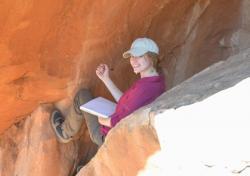 Colorado - This summer Lee University faculty, students and alumni participated in a rare archaeological excavation. The field work included exploring a Central Western Colorado rock shelter and compiling documentation of Native American rock art. Since 2007, excavation of the rock shelter has revealed a site that consistently dates to 10860 B.C. through carbon-14 dating. There are only 17 other sites in the United States with these dates. According to Dr. Gardner, “The data set being generated at this site contains the potential of answering questions about Colorado’s pre-history.” The crew found artifacts of the nomadic people that inhabited the rock shelter, including stone tools, spear points, baskets, beads, yucca rope, and straw bedding. It was inhabited from 500 to 12,000 years ago as different groups moved through the region, utilizing the natural shelter. The rock art on the walls of the rock shelter was left by native peoples of the Fremont and Anazasi cultures.
Colorado - This summer Lee University faculty, students and alumni participated in a rare archaeological excavation. The field work included exploring a Central Western Colorado rock shelter and compiling documentation of Native American rock art. Since 2007, excavation of the rock shelter has revealed a site that consistently dates to 10860 B.C. through carbon-14 dating. There are only 17 other sites in the United States with these dates. According to Dr. Gardner, “The data set being generated at this site contains the potential of answering questions about Colorado’s pre-history.” The crew found artifacts of the nomadic people that inhabited the rock shelter, including stone tools, spear points, baskets, beads, yucca rope, and straw bedding. It was inhabited from 500 to 12,000 years ago as different groups moved through the region, utilizing the natural shelter. The rock art on the walls of the rock shelter was left by native peoples of the Fremont and Anazasi cultures.
http://www.chattanoogan.com/articles/article_208795.asp
- NEPAL – 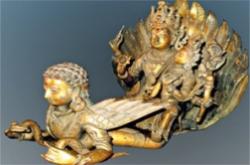 – Katmandou - Art lovers and historians have something to cheer about, for the country has got back one of its lost treasures — a beautiful idol of Laxmi-Narayan dating to the 1640s — which ‘vanished’ during the renovation of the Sundari Chowk, a part of the Patan Durbar, on November 5, 2009. Yesterday, a team of detectives from the Metropolitan Police Crime Division rounded up Prajwal Shakya (19) of Purnachandi, Lalitpur-21, Raj Kumar Tamang (31) of Kaule-4, Nuwakot and Shailesh Tamrakar (22) of Ikhalakhu, Lalitpur-18, from Lalitpur, while the three, confident that police had stopped looking for the lost idol, were holding a meeting to sell it for Rs 15 million. Senior archaeologist Prakash Darnal described the retrieval of the archaeological piece as a big achievement for the entire nation. He said King Siddhi Narsingh Malla had got sculptors to carve out the idol in the 1640s. “History has it that King Siddhi Narsingh used to offer prayers to deities in Sudari Chowk that sported the idol of Laxmi-Narayan,” Darnal said.
– Katmandou - Art lovers and historians have something to cheer about, for the country has got back one of its lost treasures — a beautiful idol of Laxmi-Narayan dating to the 1640s — which ‘vanished’ during the renovation of the Sundari Chowk, a part of the Patan Durbar, on November 5, 2009. Yesterday, a team of detectives from the Metropolitan Police Crime Division rounded up Prajwal Shakya (19) of Purnachandi, Lalitpur-21, Raj Kumar Tamang (31) of Kaule-4, Nuwakot and Shailesh Tamrakar (22) of Ikhalakhu, Lalitpur-18, from Lalitpur, while the three, confident that police had stopped looking for the lost idol, were holding a meeting to sell it for Rs 15 million. Senior archaeologist Prakash Darnal described the retrieval of the archaeological piece as a big achievement for the entire nation. He said King Siddhi Narsingh Malla had got sculptors to carve out the idol in the 1640s. “History has it that King Siddhi Narsingh used to offer prayers to deities in Sudari Chowk that sported the idol of Laxmi-Narayan,” Darnal said.
http://www.thehimalayantimes.com/fullNews.php?headline=Malla-era+archaeological+marvel+retrieved+after+two+years&NewsID=302293